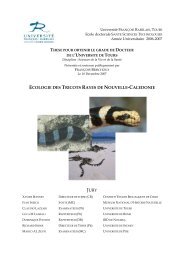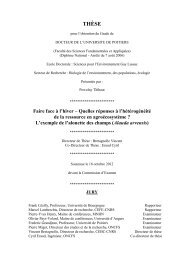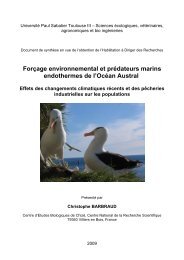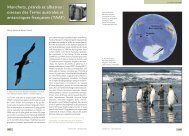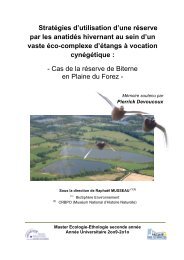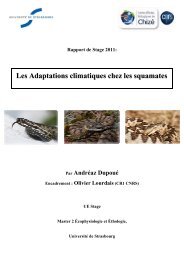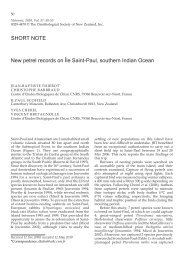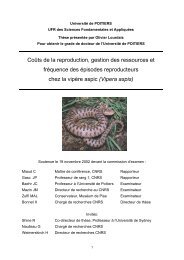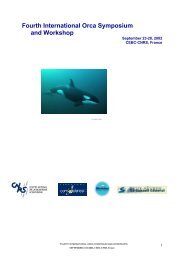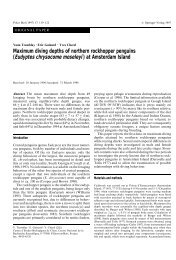Isotopic signatures, foraging habitats and trophic ... - Cebc - CNRS
Isotopic signatures, foraging habitats and trophic ... - Cebc - CNRS
Isotopic signatures, foraging habitats and trophic ... - Cebc - CNRS
Create successful ePaper yourself
Turn your PDF publications into a flip-book with our unique Google optimized e-Paper software.
162 Coral Reefs (2011) 30:155–165<br />
size. Although many factors can modify stable-isotope<br />
composition (Gannes et al. 1997; Martinez del Rio et al.<br />
2009), the patterns in our data correspond well to a priori<br />
predictions based on the hypothesis that different species,<br />
sexes <strong>and</strong> body sizes of sea kraits differ in dietary composition<br />
according to divergence in <strong>foraging</strong> <strong>habitats</strong>.<br />
The notion that the two species of New Caledonian sea<br />
kraits exploit distinct <strong>foraging</strong> grounds has been supported<br />
by data on diet composition, prey <strong>habitats</strong> (FishBase),<br />
duration of snake <strong>foraging</strong> trips <strong>and</strong> habitat-specific morphology<br />
of their anguilliform prey (see Brischoux et al.<br />
2007b, 2009). Our isotopic data provide further independent<br />
evidence in support of the habitat-divergence<br />
hypothesis <strong>and</strong> extend it to intraspecific comparisons.<br />
Importantly, the stable-isotope differences that we<br />
observed suggest that these intraspecific <strong>and</strong> interspecific<br />
niche divergences are consistent through time. For example,<br />
isotopic ratios diverged not only between the types of<br />
eels consumed by the two sea krait species but also<br />
between blood samples taken from the predators themselves.<br />
However, habitat boundaries (such as those between<br />
soft-bottoms <strong>and</strong> hard-bottoms) are unlikely to be clear-cut.<br />
As a result, our data on anguilliform fish d 13 C show<br />
extensive variation <strong>and</strong> overlap between <strong>and</strong> within<br />
species.<br />
Intraspecific dietary partitioning is widespread in<br />
snakes, typically based on body size <strong>and</strong>/or sex (Shine <strong>and</strong><br />
Wall 2007). In species with strong sexual dimorphism in<br />
body size, the effects of sex <strong>and</strong> body size on dietary<br />
composition can interact in complex ways (Shine 1991).<br />
There are two likely reasons why a snake’s body size<br />
influences the types of prey that it consumes. The first<br />
reason is that snakes are gape-limited predators (i.e., jaw<br />
size limits maximal ingestible prey size), <strong>and</strong> hence smaller<br />
snakes are unable to swallow the prey taken by larger<br />
conspecifics (Shine 1991; Arnold 1993). The second reason,<br />
<strong>and</strong> one that has attracted less scientific attention, is<br />
that smaller snakes may be able to enter the narrow crevices<br />
used by smaller species of prey (Shine 1991). Plausibly,<br />
both of these processes contribute to the tendency for<br />
larger sea kraits to consume larger prey items. Because the<br />
size distribution of eels differs between hard substrate <strong>and</strong><br />
soft substrate (Brischoux et al. 2009), any shift in prey<br />
sizes is likely to involve a shift in <strong>foraging</strong> <strong>habitats</strong> as well.<br />
Similar ontogenetic (size-related) shifts in feeding habits<br />
also occur in predatory fishes (Kawakami <strong>and</strong> Tachihara<br />
2005; Tibbetts <strong>and</strong> Carseldine 2005; Carassou et al. 2008;<br />
<strong>and</strong> present study for 3 species of anguilliform fish).<br />
In L. laticaudata, larger individuals had lower d 13 C<br />
<strong>signatures</strong>, whereas d 15 N values increased with body size<br />
in both sea krait species. These results accord well with a<br />
strong ontogenetic shift of prey types within L. laticaudata,<br />
<strong>and</strong> a significant (albeit weaker) shift in L. saintgironsi<br />
123<br />
detected through conventional gut content analyses<br />
(Brischoux et al. 2009). However, the convergence<br />
between results based on stable-isotope analyses <strong>and</strong> previous<br />
results based on stomach content analyses (Brischoux<br />
et al. 2007b, 2009) suggest that the ontogenetic shift in<br />
snake diets is linked to an ontogenetic shift in <strong>foraging</strong><br />
<strong>habitats</strong> in L. laticaudata. InL. saintgironsi, the sex differences<br />
(independent of body size) in overall isotopic<br />
signature are probably linked to the divergence in dietary<br />
composition between adult males <strong>and</strong> females (e.g., males<br />
depend on 1 main prey species versus 6 in females: see<br />
Table 1).<br />
Perhaps the most surprising divergence between the two<br />
sea krait species was in the isotopic <strong>signatures</strong> of Conger<br />
sp. Although we could not distinguish between conger eels<br />
from the two predator species on morphological criteria,<br />
these samples differed in both d 13 C <strong>and</strong> d 15 N. These differences<br />
were not linked to fish body size (both samples<br />
encompassed the same range, 30–50 cm long). We do not<br />
know whether the conger eels taken by the two sea krait<br />
taxa are different species or the same species from different<br />
<strong>habitats</strong> (e.g., hard vs. soft substrates). Regardless, the<br />
isotopic distinction between these samples provides a<br />
strong example of the power of isotopic data to tease apart<br />
superficially subtle differences in niche dimensions<br />
between sympatric predators.<br />
Both benthic predatory communities, eels (G. albimarginatus,<br />
G. moluccensis) <strong>and</strong> sea kraits (L. laticaudata <strong>and</strong><br />
L. saintgironsi), display d 15 N that sometimes exceed<br />
11.0%. These d 15 N values are similar to those found in<br />
pelagic top-predator fish species, for example, *11.5% for<br />
Scomberomorus commerson (3–7 kg) (Carassou et al.<br />
2008). Although isotopic variance in d 15 N is not always<br />
synonymous with <strong>trophic</strong> diversity, the results suggest that<br />
despite their small vertical depth, reef seafloor ecosystems<br />
could contain <strong>trophic</strong> networks as complex as those<br />
occurring at a much larger spatial scale in the overlying<br />
water column. Alternatively, but not exclusively, basal<br />
d 15 N might vary with habitat types, with soft-bottoms<br />
having higher d 15 N (as suggested by the negative relationship<br />
we detected between d 13 C <strong>and</strong> d 15 N in anguilliform<br />
fish). Future studies could usefully extend our<br />
analyses to a broader range of habitat types <strong>and</strong> <strong>trophic</strong><br />
levels.<br />
Lastly, we note some methodological caveats to our<br />
conclusions. Most notably, we lack isotopic data on many<br />
of the steps that would unambiguously link the <strong>habitats</strong>, the<br />
fish <strong>and</strong> the snakes. Obtaining such data would require<br />
extensive isotopic analyses of complex <strong>trophic</strong> chains<br />
beginning with each substrate type <strong>and</strong> their specific biofilms,<br />
through the primary producers <strong>and</strong> all the way up to<br />
top-predators. Ideally, we would also need data on seasonal<br />
variations, water flows, individual movements <strong>and</strong> the like.



